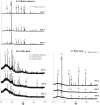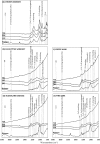Properties of biochar derived from wood and high-nutrient biomasses with the aim of agronomic and environmental benefits
- PMID: 28493951
- PMCID: PMC5426627
- DOI: 10.1371/journal.pone.0176884
Properties of biochar derived from wood and high-nutrient biomasses with the aim of agronomic and environmental benefits
Abstract
Biochar production and use are part of the modern agenda to recycle wastes, and to retain nutrients, pollutants, and heavy metals in the soil and to offset some greenhouse gas emissions. Biochars from wood (eucalyptus sawdust, pine bark), sugarcane bagasse, and substances rich in nutrients (coffee husk, chicken manure) produced at 350, 450 and 750°C were characterized to identify agronomic and environmental benefits, which may enhance soil quality. Biochars derived from wood and sugarcane have greater potential for improving C storage in tropical soils due to a higher aromatic character, high C concentration, low H/C ratio, and FTIR spectra features as compared to nutrient-rich biochars. The high ash content associated with alkaline chemical species such as KHCO3 and CaCO3, verified by XRD analysis, made chicken manure and coffee husk biochars potential liming agents for remediating acidic soils. High Ca and K contents in chicken manure and coffee husk biomass can significantly replace conventional sources of K (mostly imported in Brazil) and Ca, suggesting a high agronomic value for these biochars. High-ash biochars, such as chicken manure and coffee husk, produced at low-temperatures (350 and 450°C) exhibited high CEC values, which can be considered as a potential applicable material to increase nutrient retention in soil. Therefore, the agronomic value of the biochars in this study is predominantly regulated by the nutrient richness of the biomass, but an increase in pyrolysis temperature to 750°C can strongly decrease the adsorptive capacities of chicken manure and coffee husk biochars. A diagram of the agronomic potential and environmental benefits is presented, along with some guidelines to relate biochar properties with potential agronomic and environmental uses. Based on biochar properties, research needs are identified and directions for future trials are delineated.
Conflict of interest statement
Figures





References
-
- IPEA—Instituto de Pesquisas Aplicadas Diagnóstico dos Resíduos Orgânicos do Setor Agrossilvopastoril e Agroindústrias Associadas: Relatório de Pesquisa. Governo Federal. Brasília. 2012. http://www.ipea.gov.br/agencia/images/stories/PDFs/relatoriopesquisa/120.... Cited 30 July 2016.
-
- UNICA—União da Indústria de Cana-de-açúcar. 2016. http://www.unica.com.br/documentos/documentos/cana-de-acucar/ Cited 10 May 2016
-
- CONAB. Acompanhamento da safra brasileira: café. Safra 2016. Teceiro Lavantamento. Brasília. 2016; 1–103. http://www.conab.gov.br/OlalaCMS/uploads/arquivos/16_09_22_09_06_12_bole...
-
- Higashikawa FS, Silva CA, Bettiol W. Chemical and physical properties of organic residues. Rev Bras Ciência do Solo. 2010;34: 1742–1752.
-
- Fernandes AHBM, Alves MC, Souza RAC, Fernandes FA, Soares MTS, Crispim SMA, et al. Nitrificação e mineralização de carbono em solos tratados com dejetos de suínos biodigeridos. Boletim de Pesquisa e Desenvolvimento 111. Embrapa Pantanal. 2011;111:1–15.
MeSH terms
Substances
LinkOut - more resources
Full Text Sources
Other Literature Sources
Research Materials
Miscellaneous

